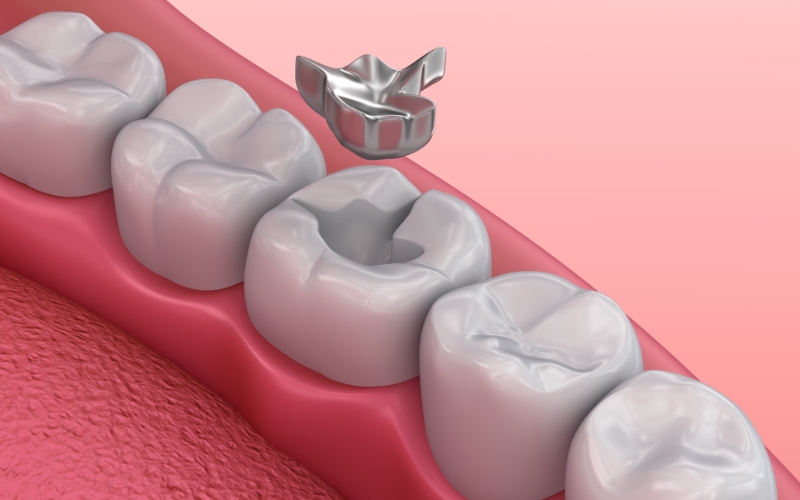1101-116 Grande Blvd, Cochrane, Alberta, T4C 2G4
Do Fillings Hurt? Debunking Common Myths About The Procedure

Dental fillings are a common solution for treating cavities, yet many people harbor fears and misconceptions about the procedure. One of the most frequent questions patients ask is, “Do fillings hurt?” If you’ve ever dreaded a trip to the dentist because of anxiety surrounding potential pain, you’re not alone.
In this blog, we will debunk common myths about dental fillings, explain what to expect during the procedure, and reassure you that with modern dentistry, discomfort is minimal.
Dental Fillings: A Brief Overview
Before addressing the pain associated with fillings, it’s essential to understand what they are and why they’re necessary. Fillings are materials used to restore the function and integrity of a tooth affected by decay or damage.
When a dentist detects a cavity, they will remove the decayed portion of the tooth and fill it with a suitable material. Common filling materials include:
- Composite Resin: A tooth-colored material that blends with natural teeth.
- Amalgam: A durable metal mixture often used for back teeth due to its strength.
- Gold: A premium option that offers excellent durability and aesthetics.
- Ceramic: Often used for its natural appearance, especially for front teeth.
Understanding these options can help you feel more at ease during your visit.
Common Myths Surrounding Them
Myth 1: Fillings Are Extremely Painful
Fact: While many people fear pain during fillings, advanced dental technologies have made the process significantly more comfortable. Modern dentists use local anesthesia to numb the area around the affected tooth, which minimizes any sensation of pain during the procedure.
Myth 2: Fillings Are Only for Cavities
Fact: Fillings can also be used to repair cracked or chipped teeth. In some cases, fillings restore the tooth’s shape and function rather than just addressing decay.
Myth 3: You Can’t Eat After Getting a Filling
Fact: While it’s advisable to wait a couple of hours after a filling before eating to allow the anesthesia to wear off, you can generally return to your normal diet afterward. If you have a temporary filling, our dentist advises you to avoid chewing hard or sticky foods for a short period.
Myth 4: Fillings Will Last a Lifetime
Fact: While fillings are designed to be durable, they don’t last forever. Depending on the material used and your oral hygiene habits, fillings may need to be replaced every 5 to 15 years.
Myth 5: All Dentists Use the Same Techniques
Fact: Dental techniques and technologies can vary widely among practitioners. Some dentists may use innovative approaches to minimize discomfort and enhance the patient’s experience. Always communicate your concerns with our dentist and ask about their methods.
What To Expect During a Filling Procedure?
Understanding what happens during a filling can ease your anxiety about the process. Here’s a step-by-step breakdown:
1. Initial Consultation
Our dentist will examine your teeth, often using X-rays to identify the extent of the decay. If a cavity is detected, they will discuss treatment options with you.
2. Numbing the Area
Once you agree to the filling, the dentist will apply a local anesthetic to numb the area around the tooth. This step is crucial in minimizing discomfort. You may feel a small pinch from the needle, but the anesthetic will quickly take effect.
3. Removing Decay
After numbing, the dentist will use a drill or laser to remove the decayed portion of the tooth. You may hear a buzzing sound, but thanks to the anesthesia, you shouldn’t feel any pain. The dentist may ask if you feel any discomfort during this process.
4. Filling The Tooth
Once the decay is removed, the dentist will clean the area and prepare it for the filling material. They will place the filling, ensuring that it is molded to fit your tooth correctly. The material will be cured or hardened, if necessary, depending on the type of filling used.
5. Final Adjustments
After the filling is in place, the dentist will check your bite to ensure it feels comfortable. They may make slight adjustments to the filling for a proper fit.
6. Post-Procedure Care
Once the procedure is complete, our dentist will provide instructions on caring for your new filling. If you received a local anesthetic, it’s wise to wait until the numbness subsides before eating or drinking.
Tips for a Smooth Filling Journey
To help ensure a positive experience while getting a filling, consider the following tips:
- Communicate with Dentist: Share any fears or concerns you may have. Dentists are trained to help ease anxiety and can modify their approach to make you more comfortable.
- Practice Relaxation Techniques: Deep breathing or visualization can help calm nerves before and during the procedure.”
- Follow Post-Procedure Care: Adhering to our dentist’s instructions can help your filling settle properly and minimize any discomfort afterward.
The fear of pain during dental fillings is understandable but often based on misconceptions. With modern anesthetics and techniques, the filling process is designed to be as comfortable as possible. By debunking common myths, we hope to alleviate your concerns and encourage proactive dental care.
If you are going through tooth pain or suspect a cavity, don’t delay seeking treatment. Addressing dental issues early can prevent more extensive procedures in the future and help maintain your overall oral health. Remember, a filling is not just a fix for decay; it’s a step toward preserving your smile.



